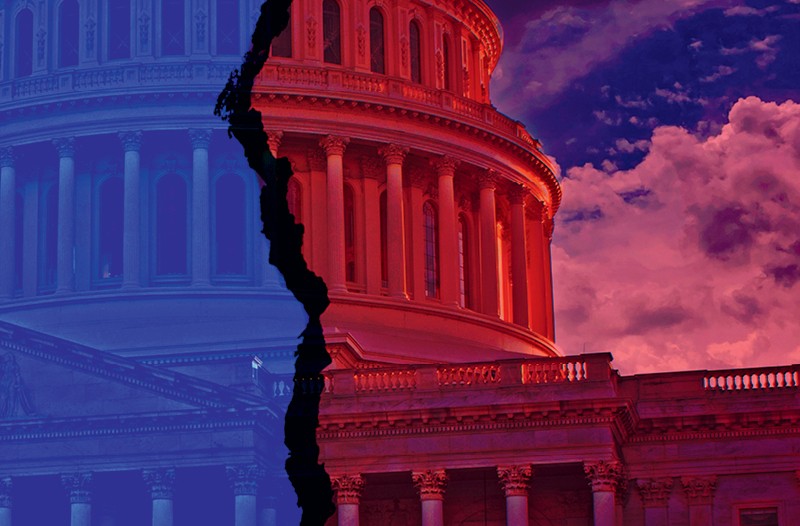
Federal Tax Bill Breakdown

Unless you’ve taken a hiatus from any and all news media (we won’t judge), you’ve heard about President Biden’s nearly $2.3 trillion spending proposal, which includes a corporate tax rate increase from 21% to 28%.
Here, we break down the potential impact on commercial brokerage with corporate tax expert George Callas, managing director of government affairs and public policy at Steptoe & Johnson.
Callas: I don’t think there’s much to be gained by trying to accuse one side or the other of tit for tat. The fact is that the process does exist and both sides do it. The 1993 Clinton tax increases were a partisan reconciliation bill. The 2001 Bush tax cuts were a partisan reconciliation bill, and so was part of the Affordable Care Act.
The reality is that when one party controls the House, the Senate and White House, there isn’t much incentive for the majority or the minority to work together. It’s unfortunate, because I think this environment leads to worse law and less enduring law because it’s law that isn’t accepted by the broader population. It’s neither party’s “fault” in my opinion. There are institutional flaws that steer things in this direction.
The remarks about “going too far” frustrate me a bit, because there were some tough choices made to raise revenue on corporations to get that rate down, and that’s always forgotten. Whenever you lower the corporate tax rate, you inevitably have to tighten the screws in other areas. That’s why you’re starting to hear some business leaders say, “If you take the rate back up, then we want our deductions again.” There’s always a give and take.
On Manchin, I don’t think anyone should assume that he’s the one Democrat holding out, just because he’s the one speaking out. We saw this last month when Bernie Sanders brought up an amendment to raise the minimum wage to $15. That vote went down 42 to 58, which means there were 8 Senate Democrats who voted “no.” There are always several Democrats standing quietly behind Joe Manchin. They’re just not speaking out because they don’t have to yet. People also forget that you can only lose four out of roughly 220 votes in the House.
Manchin has said no higher than 25%, but I would suspect there are Democrats who aren’t comfortable with 25%. We might be looking at 24% or 23% on the outer bounds.
Some of The Council’s member firms—particularly those backed by private equity—saw themselves relatively disadvantaged because the Tax Cuts and Jobs Act capped expense deductions at 30%, where there were no caps before. Likewise with the Global Intangible Low-Taxed Income (GILTI)—previously all the incentives pointed to parking your profits overseas, but under the GILTI regime that was created in the tax bill, taxes were paid as they arrived, but only at 50% of the domestic rate.
Now, we have Senators Wyden, Warner and Brown saying GILTI needs to be moved from 10.5% to 21%, which will impact many international firms, including Council members. Even the simplest insurance transactions ripple throughout the world in terms of global reinsurance. Are you hearing from your clients that the GILTI regime, combined with a higher marginal rate to begin with, is going to be problematic or am I just putting too much emphasis on this?
I don’t think you’re putting too much emphasis on it. It’s huge. And remember that it doesn’t apply to foreign headquartered multi-nationals. It only applies to U.S. headquartered multi-nationals that are operating in foreign markets, competing against those foreign multi-nationals who aren’t subject to that. You see in the Biden administration’s own proposal a tacit admission that the combination of the higher statutory rate, the higher GILTI rate and the other changes (like the per-country limitation) create their own competitiveness issues for U.S. companies.
For example, the plan has new anti-inversion rules. There hasn’t been a major inversion since 2017, so why do we need more inversion rules? We need them in a situation where we raise the corporate tax rate, and we tighten up on GILTI, because we once again create pressure to get out of the U.S. tax net. So, you’re layering increase upon increase to solve the problem.
I refer to this proposal as a Rube Goldberg machine. If you’re not familiar with Goldberg, he was a cartoonist and created these drawings where machines performed simple tasks in super complicated ways. Biden’s plan needs ALL the pieces to function properly, because the first piece creates a new problem, and so on and so on. If you take any one piece out, the whole thing crumbles and you have a huge incentive for companies to either pack up and move overseas, or risk getting beat out by foreign companies.
Additionally, you have Janet Yellen urging minimum international taxes. Obviously, members of the G20 are raising their hands in favor of that, but I can’t imagine a situation in which that would not give foreign companies a huge competitive advantage.
Switching gears to the personal side, is the tax increase for those making more than $400,000 any less murky to you now than it was during the campaign? Is it household? Is it individual?
Back to industry. Even when you lift out March and April, when the world essentially came to a halt, our industry had the biggest M&A year ever in 2020 – more than 740 transactions for billions of dollars – and that activity has continued, unabated, in 2021.
During the campaign, the Biden administration has proposed the highest possible capital gains tax rate of 39% for those firms over $1 million annually. This is up from 20%. To what extent do you think a higher capital gains tax rate will impact this activity?
This one is really about pass-throughs, since the capital gains rate for C corporations is the corporate tax rate. There’s so much that goes into this, but M&A could be affected by an increased capital gains rate because people hang onto their assets.
JCT (Joint Committee on Taxation) says, if you raise the rate to anything that starts with a three and even in the high twenties, it’ll start scoring as a revenue loss, which actually shows up as a tax cut for the rich because they’re not selling their assets and therefore paying less taxes. The only way to get to a number that starts with a three for capital gains rate is to do something about those incentives to hold your assets, and now we’re back to the Rube Goldberg machine.
They could probably raise the rate to 26, 27 or 28% and still get a little revenue, but to get it into the 30s there would have to be some major change to longstanding tax code provisions, such as realizing capital gains at death instead of allowing a step-up in basis, which is politically possible but a much heavier lift.
I don’t know that this was intentional, but in 2017, Council members on the pass-through side successfully got through Treasury an exception for insurance brokerage to get that 20% rate (which real estate brokerage also got, but other players in financial services did not). That exception is set to expire in 2025.
Thoughts on how things might change in four years? Are you seeing anything from the Biden administration that would lead you to believe this exception could be impacted prior to 2025?
Yes, this could change prior to 2025. Biden has proposed phasing out the 199A deduction starting at $400,000 income. Ironically, in my mind that actually would turn 199A on its head from its original purpose. If you recall, the whole idea was to create some level of rate parity for pass-throughs with C corporations, but that’s really only an issue for pass-throughs that are in a higher bracket. The goal was to create a more level playing field, but if you limit it to only people in those lower brackets, you’ve completely negated the original purpose.
Now, in terms of the 2025 outlook, there will be two congressional elections and another presidential election before that gets litigated, unless Congress acts years ahead of time which doesn’t generally happen. Given how quickly the pendulum swings back and forth during elections, it’s difficult to say which party will have a majority and more negotiating leverage when we come upon that deadline.
Acknowledging that Manchin is not the lone holdout, to your earlier point, he said recently in The Washington Post that there will be “no give” on the current infrastructure package through budget reconciliation.
Do you envision a process where Republicans engage in a conversation about an infrastructure package that is big enough to satisfy Democrats with tax adjustments and tax increases of any kind?
I think this gets back to our discussion earlier about the way the incentives line up. Is there an infrastructure package, maybe in the range of hundreds of billions of dollars, that 60 Senate Republicans would support? I think the answer is yes. In fact, I think you could even get 80 or 90. Let’s say it’s a half-trillion-dollar package without significant tax increases, largely deficit-financed with maybe some small offsets. I think that could happen. However, I think the incentive for Republicans to go much further than that and give Democrats a big win is virtually zero.
Then I look at the likelihood of Democrats giving up their appetite for trillions of dollars along with tax increases for corporations, high-net-worth individuals and pass-throughs. Again, I think the incentive for them to throw those priorities aside for the sake of bipartisanship is also zero. So, we’ve come full circle during this conversation. I don’t lay blame at anyone’s feet—the political pressure is such that it’s very hard to find a middle ground.
I think people are still sifting through the wreckage of this Senate parliamentarian ruling. I’m hearing a lot of speculation on what it means, but there’s nothing iron-clad. I will say that there are some big tax provisions, that are important to both sides, that are expiring at the end of 2021—dealing with interest expense, R&D, the childcare credit, EITC, and so on.
Regardless of whether or not there can be another reconciliation bill this year, there are appropriations and those expire September 30. Traditionally you can’t put annual appropriations in a reconciliation bill – that has to be a four-cornered bipartisan deal. But you can envision a short-term Continuing Resolution that kicks the September 30 deadline into December. That’s a very common path. And if you get a large December omnibus, that’s sometimes big enough to carry a tax title. So, there may be another 2021 tax package that could be bipartisan—one that is not part of infrastructure or this “Caring Economy” plan—where Democrats will need Republicans to get to 60 votes.




